Research Proposal v2
Leo_UTM
2025-09-28 09:39
原创
论文写作

<!-- markdown -->
# Research Proposal v2
**TOPIC:** Organizational Agility Accelerating Product Innovation with AI Empowerment: A Case Study of Company Y
## 1. Executive Summary (0.5-1 page)
This research proposal investigates how Artificial Intelligence (AI) empowerment enhances organizational agility to accelerate product innovation in Chinese start-ups, using Company Y as a comprehensive case study. The study employs a primarily qualitative research approach with minimal quantitative indicators for reference, focusing on understanding the mechanisms and experiences of AI-driven organizational transformation.
Company Y, an IT start-up based in Suzhou, China, represents a typical case of Chinese start-ups struggling with innovation acceleration due to limited AI integration, despite operating in a rapidly digitalizing market environment. The company faces critical challenges including absence of AI integration in development processes, prolonged development cycles, and competitive disadvantage against AI-empowered competitors.
This study employs a dual-phase action research methodology to implement and evaluate AI empowerment strategies. Phase 1 focuses on AI tool integration (Tongyi Lingma, Zhipu AI, Cursor, 即梦AI, and company self-developed tools) combined with agile methodologies, while Phase 2 examines how AI-enhanced organizational capabilities drive sustained innovation acceleration. The research emphasizes qualitative analysis through in-depth interviews, participant observations, and thematic analysis to understand stakeholder experiences and organizational transformation processes.
Expected outcomes include deep qualitative insights into AI empowerment's impact on organizational agility dimensions and product innovation acceleration. The research aims to contribute two Scopus-indexed journal publications providing theoretical insights and practical frameworks for AI-driven organizational transformation in start-up contexts.
### a. Keywords
AI Empowerment, Organizational Agility, Product Innovation, Chinese Start-ups, Qualitative Research
## 2. Research Background
The contemporary business landscape is characterized by rapid technological advancement, with Artificial Intelligence emerging as a transformative force that fundamentally alters organizational capabilities and innovation processes. In China's dynamic start-up ecosystem, AI empowerment has become a critical differentiator, enabling organizations to achieve unprecedented levels of agility and innovation acceleration.
China's AI ecosystem presents unique characteristics that distinguish it from Western contexts. Major corporations like Alibaba (Tongyi Lingma), Tencent, and Baidu (Zhipu AI) have created comprehensive AI infrastructure supporting start-up innovation. Additionally, emerging AI platforms like 即梦AI and the development of proprietary AI tools by start-ups themselves represent the democratization of AI capabilities. The "New Generation Artificial Intelligence Development Plan" positions China to become a global AI leader by 2030, creating favorable conditions for AI-empowered organizational transformation.
Despite these advantages, many Chinese start-ups struggle to effectively integrate AI technologies into their operational processes and innovation workflows. Company Y exemplifies this challenge, operating in a competitive market while lacking systematic AI integration, resulting in prolonged development cycles and reduced competitive positioning.
Current research on AI and organizational agility remains fragmented, with limited qualitative understanding of how specific AI tools and integration strategies drive organizational transformation. This research addresses this gap by providing comprehensive qualitative analysis of AI empowerment mechanisms and their impacts on organizational transformation through deep ethnographic study.
## 3. Problem Statement
Chinese start-ups face significant challenges in leveraging AI technologies to enhance organizational agility and accelerate product innovation, despite operating within supportive policy environments and advanced digital infrastructure. The absence of systematic AI integration creates competitive disadvantages and limits innovation potential.
Company Y specifically faces four interconnected AI-related challenges:
1. **Absence of Comprehensive AI Integration**: The company lacks systematic integration of diverse AI tools including commercial platforms (Tongyi Lingma, Zhipu AI, Cursor, 即梦AI) and self-developed AI capabilities, creating organizational capability gaps.
2. **Competitive Disadvantage**: Competitors leveraging comprehensive AI ecosystems for automation and data analysis outpace Company Y in efficiency and innovation speed, exacerbating competitive positioning challenges.
3. **Limited AI-Enhanced Development Capabilities**: Traditional development processes lack AI augmentation for routine task automation, data analysis, and development acceleration across the full spectrum of available AI tools.
4. **Insufficient AI-Driven Market Sensing**: The company fails to leverage AI technologies for real-time market analysis, customer insight generation, and competitive intelligence gathering through both commercial and proprietary AI solutions.
These challenges manifest in tangible business consequences including extended development cycles, suboptimal resource utilization, poor market responsiveness, and limited innovation quality. Without systematic AI empowerment interventions, Company Y risks continued erosion of competitive advantage and growth prospects.
## 4. Hypothesis
**Primary Hypothesis (H1)**: Systematic integration of diverse AI tools (commercial and self-developed) significantly enhances organizational agility dimensions through qualitatively observable transformations in sensing, responding, learning, and adaptive capabilities, leading to product innovation acceleration in Chinese start-up contexts.
**Secondary Hypotheses**:
- **H2**: AI empowerment through multiple tool categories (Tongyi Lingma, Zhipu AI, Cursor, 即梦AI, self-developed tools) creates synergistic organizational learning effects that amplify individual tool benefits when implemented systematically.
- **H3**: AI-enhanced organizational agility mediates the relationship between comprehensive AI tool integration and qualitative improvements in product innovation processes.
- **H4**: Chinese market characteristics (digital infrastructure, policy support, competitive intensity) influence the qualitative experiences and effectiveness of AI empowerment interventions on organizational transformation outcomes.
## 5. Research Questions
**Primary Research Question (RQ1)**: How does comprehensive AI empowerment enhance organizational agility to accelerate product innovation in Chinese start-up contexts, and what are the qualitative mechanisms underlying this transformation?
**Secondary Research Questions**:
- **RQ2**: What specific AI tools and integration strategies (including commercial platforms and self-developed solutions) most effectively enhance different dimensions of organizational agility from stakeholder perspectives?
- **RQ3**: How do AI-empowered organizational capabilities translate into qualitatively observable product innovation acceleration outcomes and stakeholder experiences?
- **RQ4**: What organizational and contextual factors influence stakeholder experiences and the effectiveness of AI empowerment interventions in start-up environments?
- **RQ5**: How can Chinese start-ups develop sustainable AI-enhanced organizational agility capabilities for long-term competitive advantage based on qualitative insights and organizational learning?
## 6. Literature Review
### 6.1 Theoretical Foundations
**Dynamic Capabilities Theory** provides the primary theoretical lens for understanding AI empowerment as a strategic capability enhancement mechanism. AI technologies augment organizational sensing capabilities through advanced data analytics, enhance seizing capabilities through automated decision-making, and strengthen transforming capabilities through adaptive learning systems. This theory guides the qualitative investigation of how AI tools reshape organizational capabilities.
**Resource-Based View (RBV)** explains how AI technologies constitute valuable, rare, inimitable, and non-substitutable (VRIN) resources that create sustainable competitive advantage. The integration of both commercial AI platforms and self-developed AI tools transforms organizational capabilities from static to dynamic, enabling continuous adaptation and innovation acceleration.
**Innovation Diffusion Theory** guides understanding of how AI technologies spread through organizational systems and achieve adoption. The theory's five innovation characteristics (relative advantage, compatibility, complexity, trialability, observability) inform qualitative analysis of AI integration experiences and adoption patterns.
### 6.2 AI Empowerment in Organizational Contexts
Contemporary research demonstrates that AI integration significantly enhances organizational capabilities across multiple dimensions. AI tools automate routine tasks, enhance data analysis capabilities, improve decision-making speed, and enable predictive insights that support strategic planning. However, most existing research focuses on quantitative outcomes rather than qualitative transformation experiences.
In Chinese contexts, AI empowerment benefits from advanced digital infrastructure and government policy support. The accessibility of AI tools has dramatically increased, with platforms like Tongyi Lingma (intelligent code assistance), Zhipu AI (data analysis and insights), Cursor (collaborative development), 即梦AI (creative AI solutions), and self-developed proprietary tools enabling systematic integration for resource-constrained start-ups.
### 6.3 AI Applications in Product Development Lifecycle
AI applications span the entire product development lifecycle:
- **Market Research Phase**: AI enables demand forecasting through large-scale data analysis and consumer behavior prediction
- **Design and Prototyping**: Generative AI models (including 即梦AI) simulate user interactions and optimize product features based on predictive analytics
- **Development Phase**: AI tools automate routine coding tasks, enhance testing efficiency, and accelerate deployment processes through both commercial and self-developed solutions
- **Post-Launch Phase**: AI-powered analytics provide real-time user behavior insights, enabling rapid iteration and personalized experiences
### 6.4 Research Gaps
Current literature lacks comprehensive qualitative evidence on:
1. Stakeholder experiences with systematic integration of multiple AI tool categories within single organizational contexts
2. Qualitative mechanisms through which AI empowerment enhances organizational agility dimensions
3. In-depth understanding of AI integration impacts on product innovation acceleration processes
4. Contextual factors influencing AI empowerment effectiveness in Chinese start-up environments from participant perspectives
## 7. Research Objectives
**Primary Objective (RO1)**: To investigate how comprehensive AI empowerment enhances organizational agility to accelerate product innovation in Chinese start-up contexts through qualitative analysis of systematic AI integration strategies and stakeholder experiences.
**Secondary Objectives**:
- **RO2**: To identify and analyze through qualitative methods specific AI tools and integration approaches (commercial and self-developed) that most effectively enhance different dimensions of organizational agility
- **RO3**: To understand through stakeholder perspectives the impact of AI empowerment on product innovation acceleration processes including development efficiency, innovation quality, and market responsiveness
- **RO4**: To develop practical frameworks and guidelines for AI empowerment implementation in resource-constrained start-up environments based on qualitative insights
- **RO5**: To contribute theoretical understanding of AI empowerment mechanisms and their relationship to organizational transformation outcomes through qualitative research
## 8. Methodology
### 8.1 Research Design
This study employs a **dual-phase action research methodology** with **primarily qualitative approach** specifically designed to implement and evaluate AI empowerment strategies within Company Y's organizational context. The research follows a **qualitative-dominant mixed-methods approach** emphasizing deep understanding of AI integration experiences and organizational transformation processes, with minimal quantitative indicators for reference purposes only.
**Research Philosophy**: Interpretive approach emphasizing understanding of stakeholder experiences and meaning-making
**Research Approach**: Abductive reasoning integrating theoretical frameworks with qualitative discoveries
**Research Strategy**: Single case study using Company Y as comprehensive investigation context
**Time Horizon**: Longitudinal design spanning 24 months (October 2025 - September 2027)
### 8.2 Dual-Phase Implementation Framework
**Phase 1: Comprehensive AI Tool Integration (Weeks 1-12)**
- Systematic implementation of five AI tool categories: Tongyi Lingma (intelligent code assistance), Zhipu AI (data analysis and customer insights), Cursor (collaborative development environments), 即梦AI (creative AI solutions), and company self-developed AI tools
- Integration with SCRUM methodology to create AI-enhanced agile development processes
- Focus on understanding stakeholder experiences with efficiency enhancement through automation and process optimization
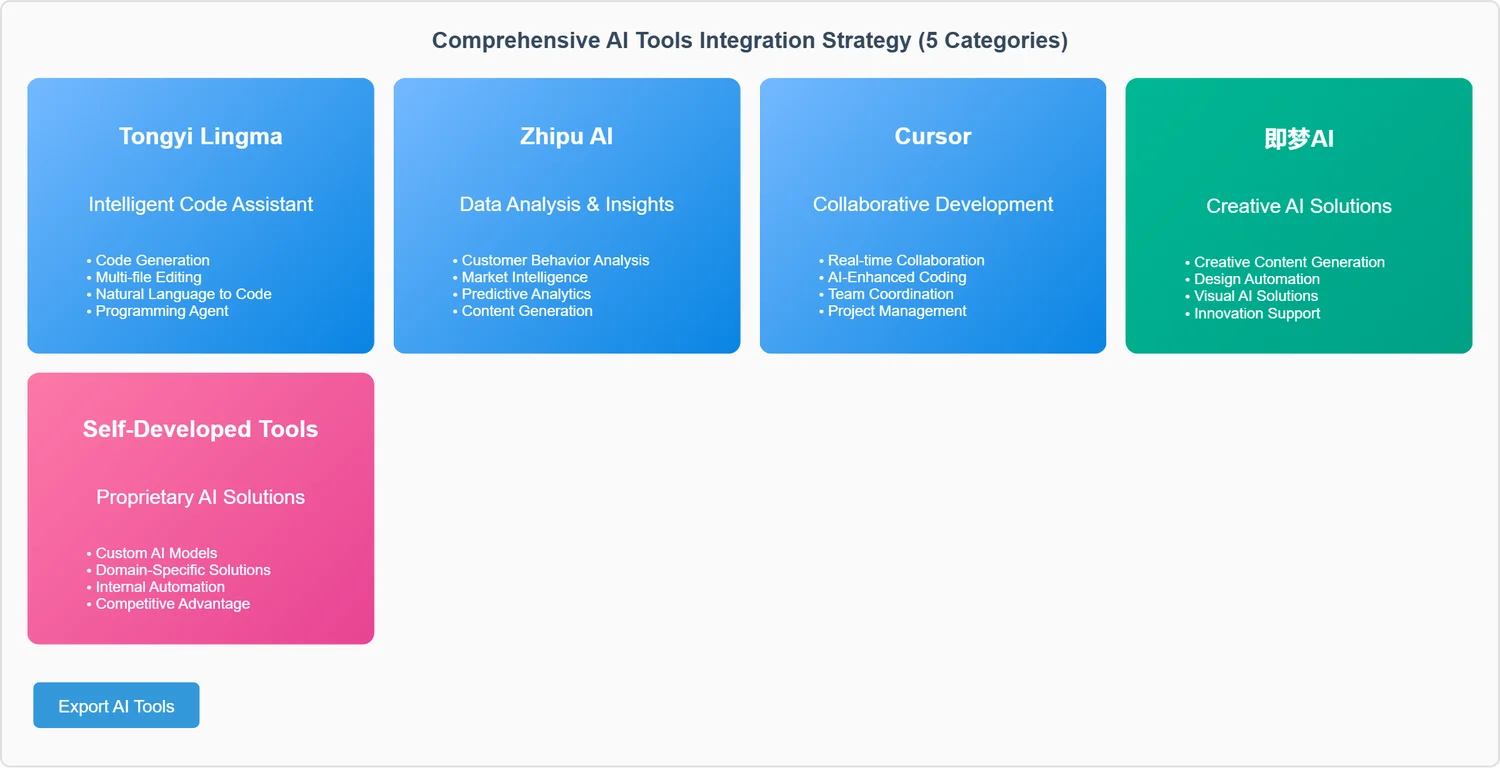
**Phase 2: AI-Enhanced Organizational Capabilities (Weeks 13-24)**
- Development of AI-empowered sensing capabilities for market intelligence and customer insights
- Enhancement of AI-supported decision-making and response mechanisms
- Implementation of AI-driven learning systems and knowledge management platforms
- Emphasis on qualitative understanding of organizational transformation processes
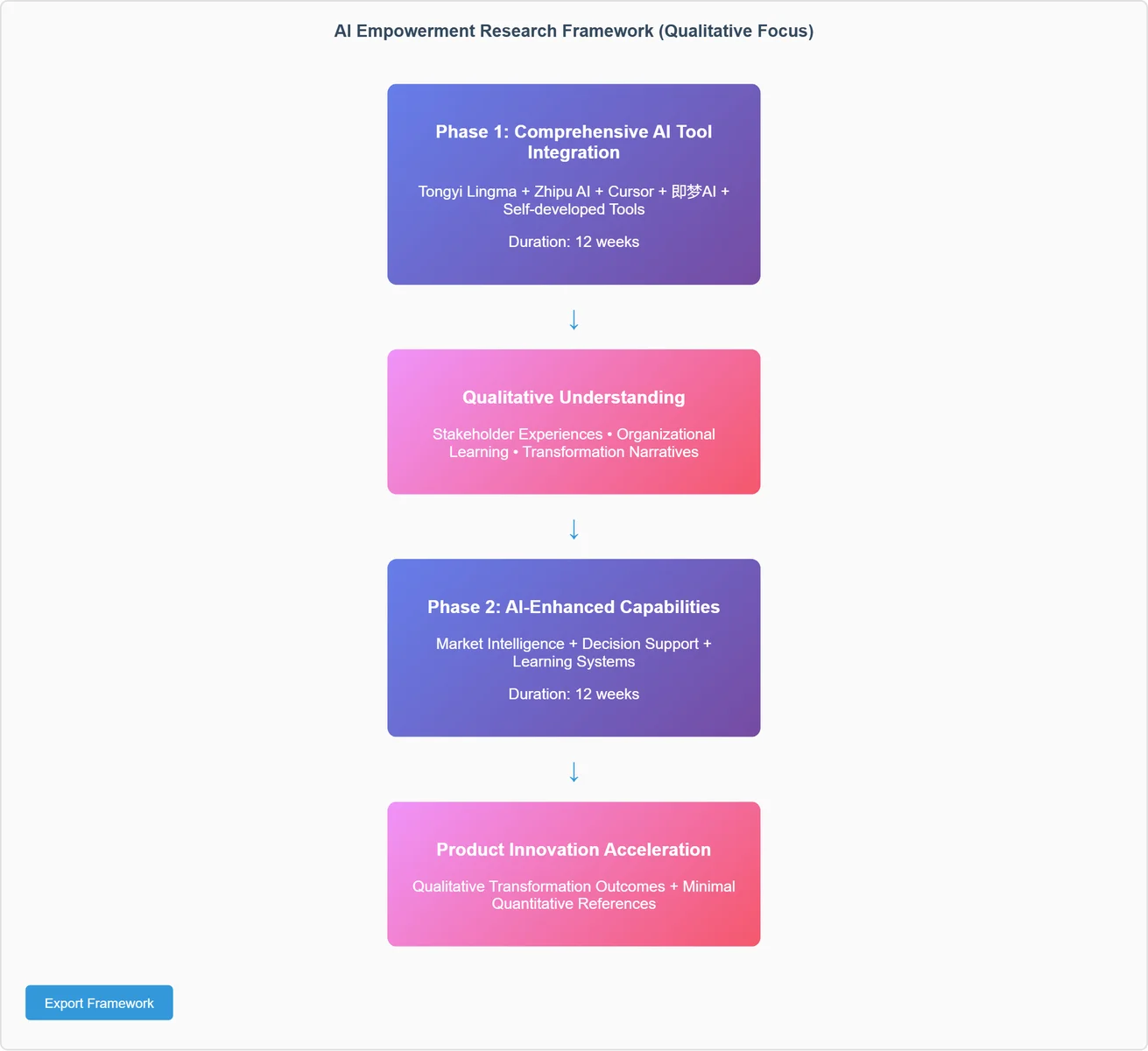
### 8.3 Data Collection Methods (Primarily Qualitative)
**Primary Qualitative Data Collection**:
- **In-depth Semi-structured Interviews**: Monthly interviews with all team members and stakeholders (30+ participants) focusing on AI integration experiences, challenges, and transformation perceptions
- **Participant Observation**: Continuous ethnographic observation of AI-enhanced development processes, team interactions, and organizational behaviors
- **Focus Groups**: Bi-weekly focus group sessions examining AI empowerment experiences and organizational transformation
- **Document Analysis**: Analysis of project reports, AI implementation outcomes, internal communications, and organizational artifacts
- **Reflective Journals**: Stakeholder reflection journals documenting AI integration experiences and learning processes

**Minimal Quantitative Indicators (Reference Only)**:
- Basic AI Tool Adoption Rates (weekly tracking for context)
- Development Cycle Time Indicators (general reference points)
- Simple Innovation Performance Metrics (user adoption trends, basic satisfaction indicators)
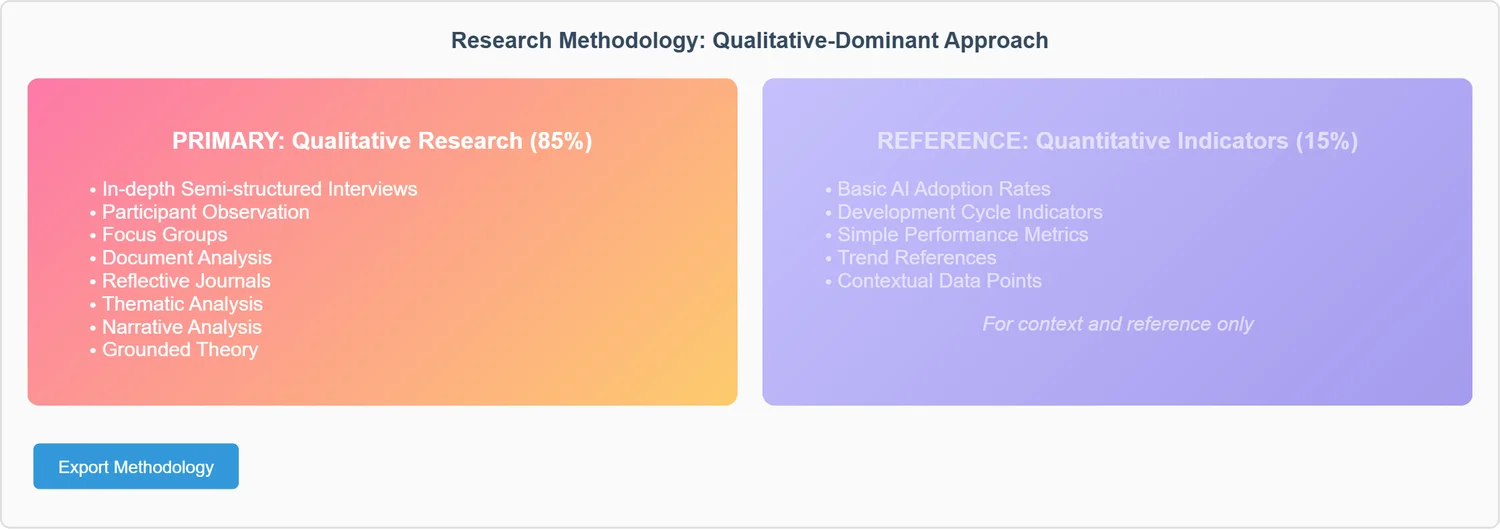
### 8.4 Sampling and Participants
**Primary Participants**: All Company Y employees (30 individuals) across R&D, marketing, management, and customer service functions - comprehensive qualitative coverage
**Key Informants**: 8 team leaders and managers with direct AI implementation experience - intensive interview subjects
**Customer Advisory Panel**: 10-30 members recruited through social media engagement and MVP co-creation activities - qualitative feedback providers
**External Experts**: AI technology specialists and organizational transformation consultants for validation and qualitative insights
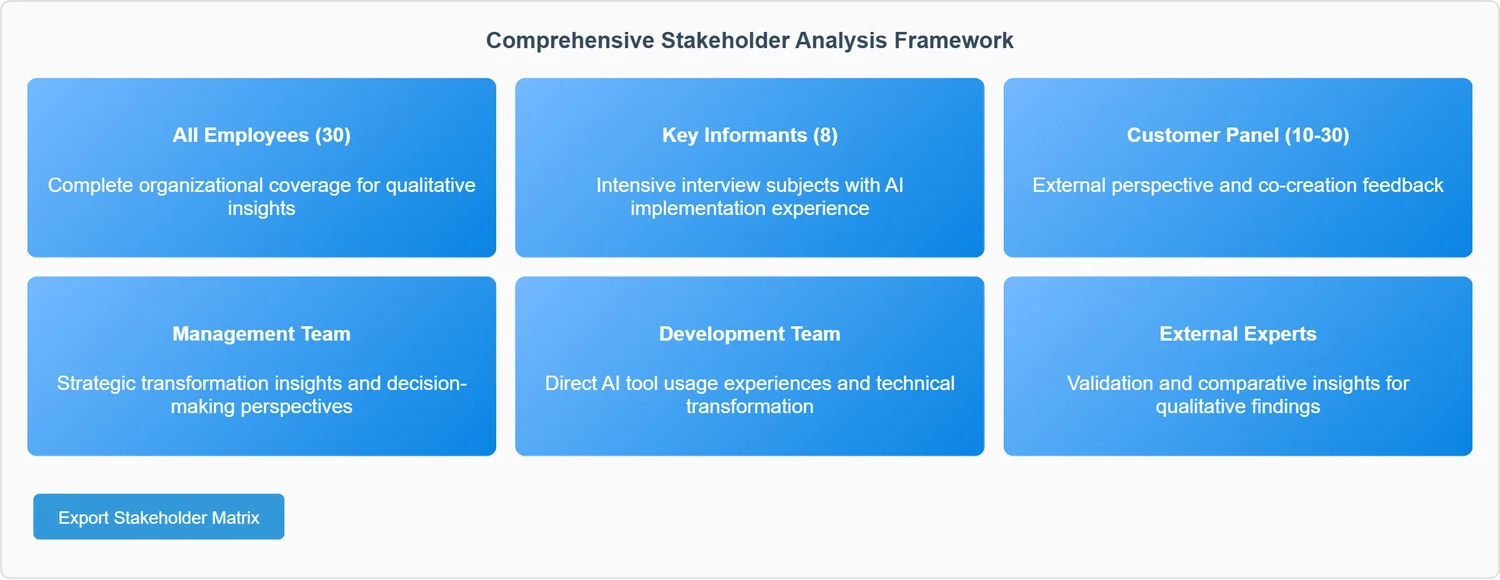
### 8.5 Data Analysis (Primarily Qualitative)
**Primary Qualitative Analysis**:
- **Thematic Analysis**: Following Braun and Clarke's (2006) framework for identifying patterns in AI empowerment experiences
- **Narrative Analysis**: Understanding stakeholder stories and transformation journeys
- **Grounded Theory Approach**: Building theoretical understanding from qualitative data
- **NVivo Software**: Systematic qualitative data management and coding consistency
- **Phenomenological Analysis**: Understanding lived experiences of AI integration and organizational transformation
**Minimal Quantitative Analysis (Reference Only)**:
- Basic descriptive statistics for contextual understanding
- Simple trend analysis for reference purposes
- Effect indicators for general direction assessment
**Integration Strategy**:
- Qualitative findings drive analysis and interpretation
- Quantitative indicators provide contextual reference only
- Triangulation through multiple qualitative data sources
- Member checking and stakeholder validation of qualitative findings
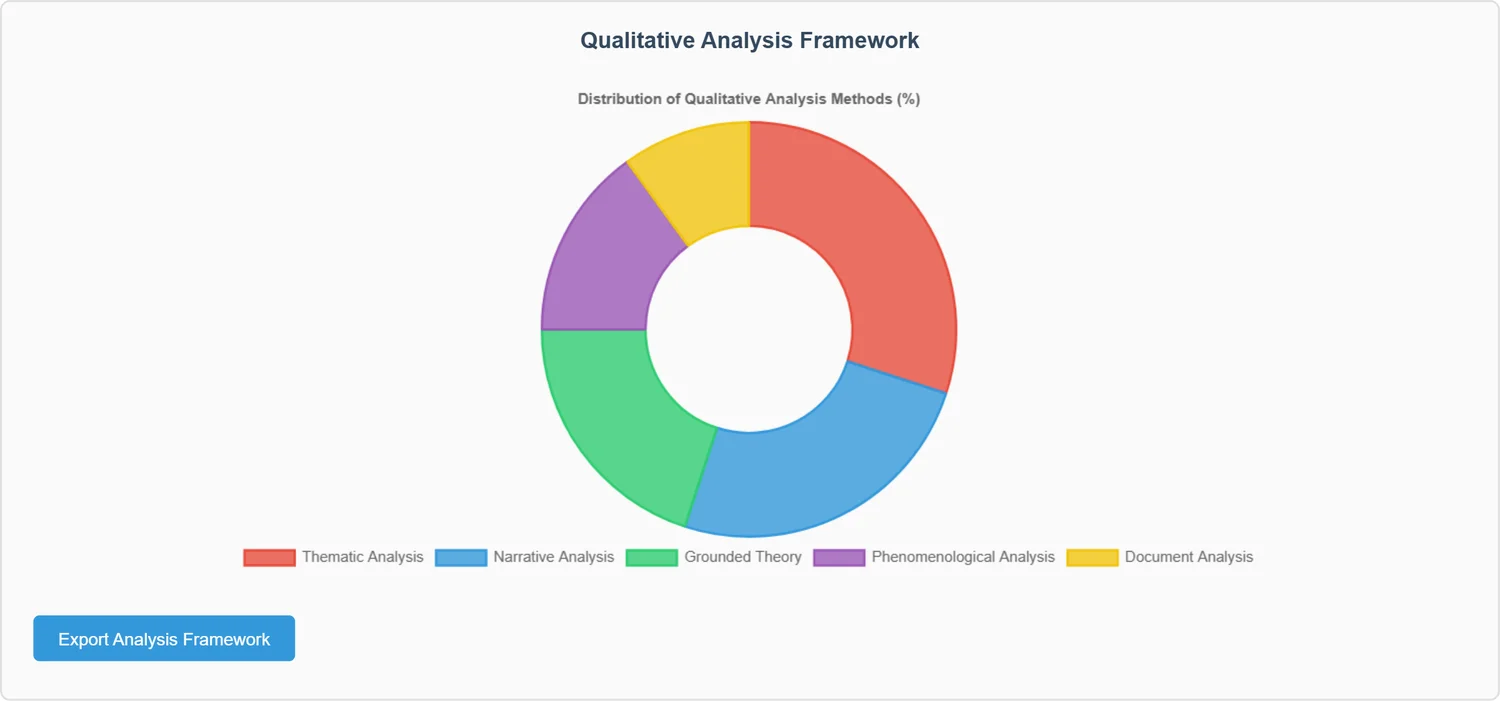
## 9. Flow Chart of Research Activities
```
Phase 1: Preparation & Baseline (Months 1-2)
├── Literature Review Completion (Qualitative Focus)
├── Theoretical Framework Finalization
├── Qualitative Data Collection Instrument Development
├── Ethical Approval and Consent Procedures
├── Baseline Qualitative Assessment (T1)
└── AI Tool Selection and Procurement (5 categories)
Phase 2: Comprehensive AI Tool Integration (Months 3-8)
├── Week 1-3: Tongyi Lingma Integration
│ ├── Installation and Configuration
│ ├── Team Training and Onboarding
│ ├── Qualitative Experience Tracking
│ └── In-depth Interviews (T2)
├── Week 4-6: Zhipu AI Integration
│ ├── Data Analysis Platform Setup
│ ├── Customer Insight Generation Training
│ ├── Integration with Existing Systems
│ └── Focus Groups and Interviews (T3)
├── Week 7-9: Cursor Integration
│ ├── Collaborative Development Environment Setup
│ ├── Team Collaboration Process Redesign
│ ├── Participant Observation
│ └── Qualitative Assessment (T4)
├── Week 10-12: 即梦AI and Self-developed Tools Integration
│ ├── Creative AI Solutions Implementation
│ ├── Proprietary Tool Development and Integration
│ ├── Comprehensive Experience Documentation
│ └── Phase 1 Qualitative Evaluation (T5)
└── Phase 1 Qualitative Analysis and Synthesis
Phase 3: AI-Enhanced Organizational Capabilities (Months 9-14)
├── Week 13-16: AI-Empowered Sensing Capabilities
│ ├── Market Intelligence System Development
│ ├── Real-time Customer Feedback Integration
│ ├── Competitive Analysis Automation
│ └── Stakeholder Experience Analysis (T6)
├── Week 17-20: AI-Supported Decision-Making
│ ├── Automated Decision Support Systems
│ ├── Predictive Analytics Implementation
│ ├── Resource Optimization Algorithms
│ └── Decision-Making Process Analysis (T7)
├── Week 21-24: AI-Driven Learning Systems
│ ├── Knowledge Management Platform Development
│ ├── Continuous Learning Mechanism Implementation
│ ├── Organizational Memory Systems
│ └── Learning Process Qualitative Assessment (T8)
└── Phase 2 Comprehensive Qualitative Analysis
Phase 4: Integration Evaluation & Sustainability (Months 15-20)
├── Comprehensive Qualitative Impact Assessment
├── Long-term Sustainability Planning
├── Best Practices Documentation
├── Final Stakeholder Interviews and Focus Groups (T9)
└── Results Synthesis and Theoretical Development
Phase 5: Dissemination & Publication (Months 21-24)
├── Academic Paper 1: AI Empowerment Mechanisms (Qualitative Focus)
├── Academic Paper 2: Organizational Transformation Experiences
├── Conference Presentations
├── Practical Guidelines Development
└── Final Report Completion
```
## 10. Research Activities
### 10.1 Pre-Implementation Activities (Months 1-2)
- Comprehensive literature review focusing on qualitative studies of AI empowerment and organizational agility
- Theoretical framework development and qualitative research instrument design
- Ethical approval procedures and informed consent protocols for intensive qualitative research
- Baseline qualitative assessment and organizational ethnographic study
- AI tool evaluation, selection, and procurement processes (5 categories including 即梦AI and self-developed tools)
### 10.2 Phase 1 Implementation Activities (Months 3-8)
- **Tongyi Lingma Integration**: Installation, configuration, team training, and qualitative experience tracking
- **Zhipu AI Integration**: Data analysis platform setup, customer insight training, stakeholder experience analysis
- **Cursor Integration**: Collaborative environment setup, process redesign, participant observation
- **即梦AI Integration**: Creative AI solutions implementation and user experience documentation
- **Self-developed Tools Integration**: Proprietary AI tool development and integration experience analysis
- Continuous qualitative data collection and preliminary thematic analysis
- Weekly stakeholder reflection sessions and experience documentation
### 10.3 Phase 2 Implementation Activities (Months 9-14)
- **AI-Empowered Sensing**: Market intelligence system development and stakeholder experience analysis
- **AI-Supported Decision-Making**: Decision support systems implementation and decision-making process transformation study
- **AI-Driven Learning**: Knowledge management platforms and organizational learning transformation analysis
- Advanced qualitative data collection and pattern identification
- Monthly stakeholder interviews and bi-weekly focus group sessions
### 10.4 Evaluation and Analysis Activities (Months 15-20)
- Comprehensive qualitative impact assessment across all organizational agility dimensions
- Thematic analysis of qualitative data and narrative analysis of transformation experiences
- Grounded theory development and findings synthesis
- Sustainability planning and best practices documentation based on qualitative insights
- External validation and expert review processes through qualitative methods
### 10.5 Dissemination Activities (Months 21-24)
- Academic publication development focusing on qualitative findings and theoretical contributions
- Conference presentation preparation emphasizing qualitative insights
- Practical guidelines and framework development based on stakeholder experiences
- Final report compilation and stakeholder presentation
- Knowledge transfer and implementation support based on qualitative learning
## 11. Milestones and Dates
| Milestone | Target Date | Deliverable |
|-----------|-------------|-------------|
| Research Proposal Approval | October 31, 2025 | Approved research proposal and ethical clearance |
| Baseline Qualitative Assessment Complete | December 31, 2025 | Comprehensive baseline ethnographic report |
| Phase 1 AI Integration Complete | June 30, 2026 | AI tool integration report and qualitative findings |
| Phase 2 Capabilities Enhancement Complete | December 31, 2026 | Organizational transformation qualitative assessment |
| Comprehensive Qualitative Analysis Complete | June 30, 2027 | Complete qualitative analysis and theoretical synthesis |
| First Academic Paper Submission | July 31, 2027 | Scopus-indexed journal submission (qualitative focus) |
| Second Academic Paper Submission | August 31, 2027 | Scopus-indexed journal submission (transformation experiences) |
| Final Report and Guidelines Complete | September 30, 2027 | Final research report and practical guidelines |
### Key Deliverables Timeline
**Year 1 (October 2025 - September 2026)**:
- Month 3: Baseline qualitative assessment and comprehensive AI tool selection
- Month 6: Tongyi Lingma and Zhipu AI integration experiences
- Month 9: Cursor and 即梦AI integration qualitative analysis
- Month 12: Self-developed tools integration and comprehensive experience synthesis
**Year 2 (October 2026 - September 2027)**:
- Month 15: AI-empowered organizational capabilities qualitative assessment
- Month 18: Comprehensive qualitative impact evaluation and sustainability planning
- Month 21: First academic paper submission (AI empowerment mechanisms - qualitative)
- Month 24: Second academic paper submission (organizational transformation experiences)
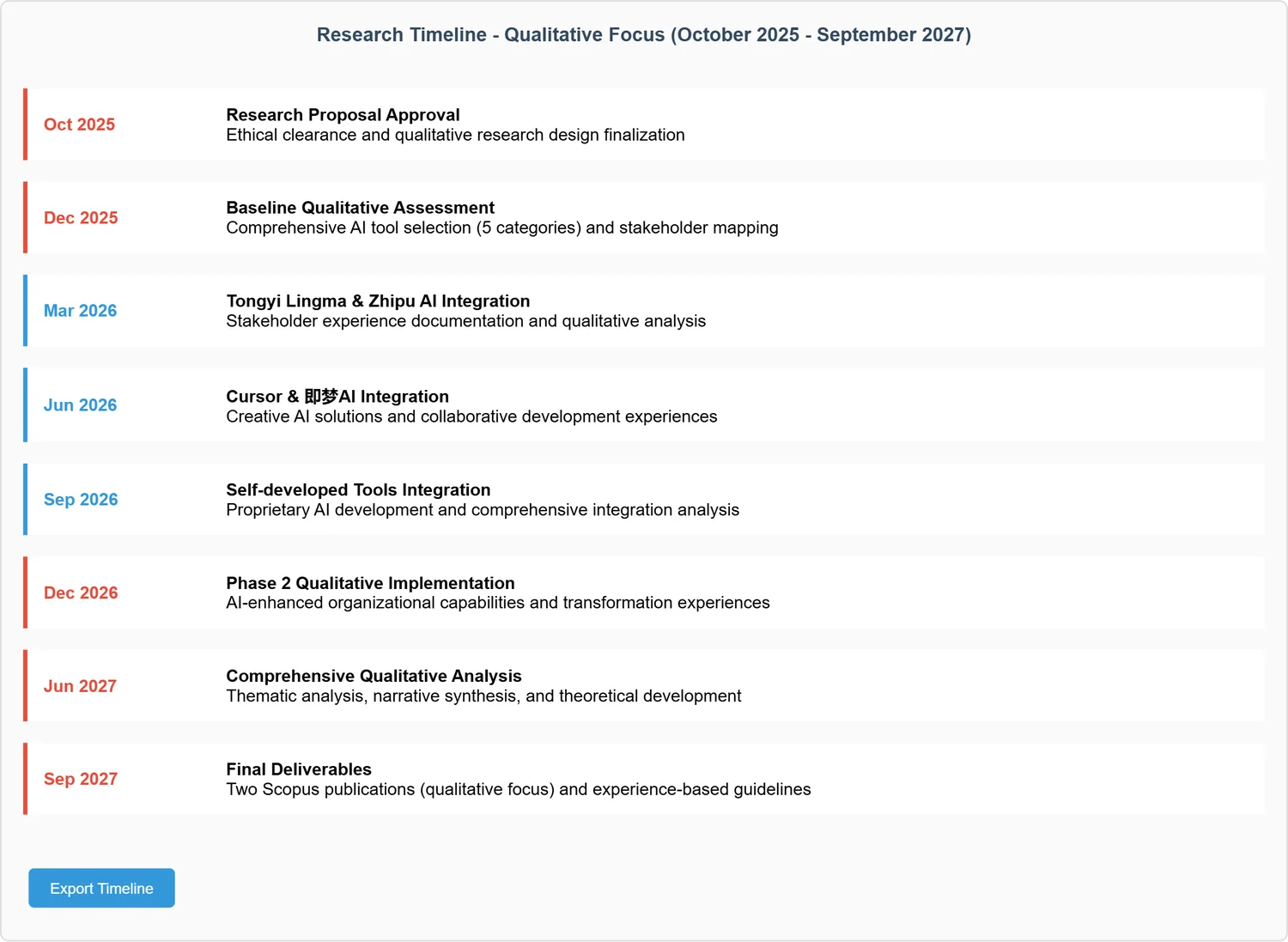
## 12. Expected Results / Benefits
### 12.1 Theoretical Contributions
**Qualitative Understanding of AI Empowerment Mechanisms**: The research will provide comprehensive qualitative insights demonstrating how specific AI tools (Tongyi Lingma, Zhipu AI, Cursor, 即梦AI, self-developed tools) enhance organizational agility dimensions through stakeholder experiences and transformation narratives.
**Dynamic Capabilities Theory Extension**: Findings will extend dynamic capabilities theory through qualitative understanding of how AI technologies augment sensing, seizing, and transforming capabilities in resource-constrained start-up environments, based on lived experiences and organizational learning processes.
**AI-Organizational Agility Qualitative Framework**: Development of a comprehensive qualitative framework explaining the relationships between AI empowerment, organizational agility enhancement, and product innovation acceleration outcomes through stakeholder perspectives and transformation experiences.
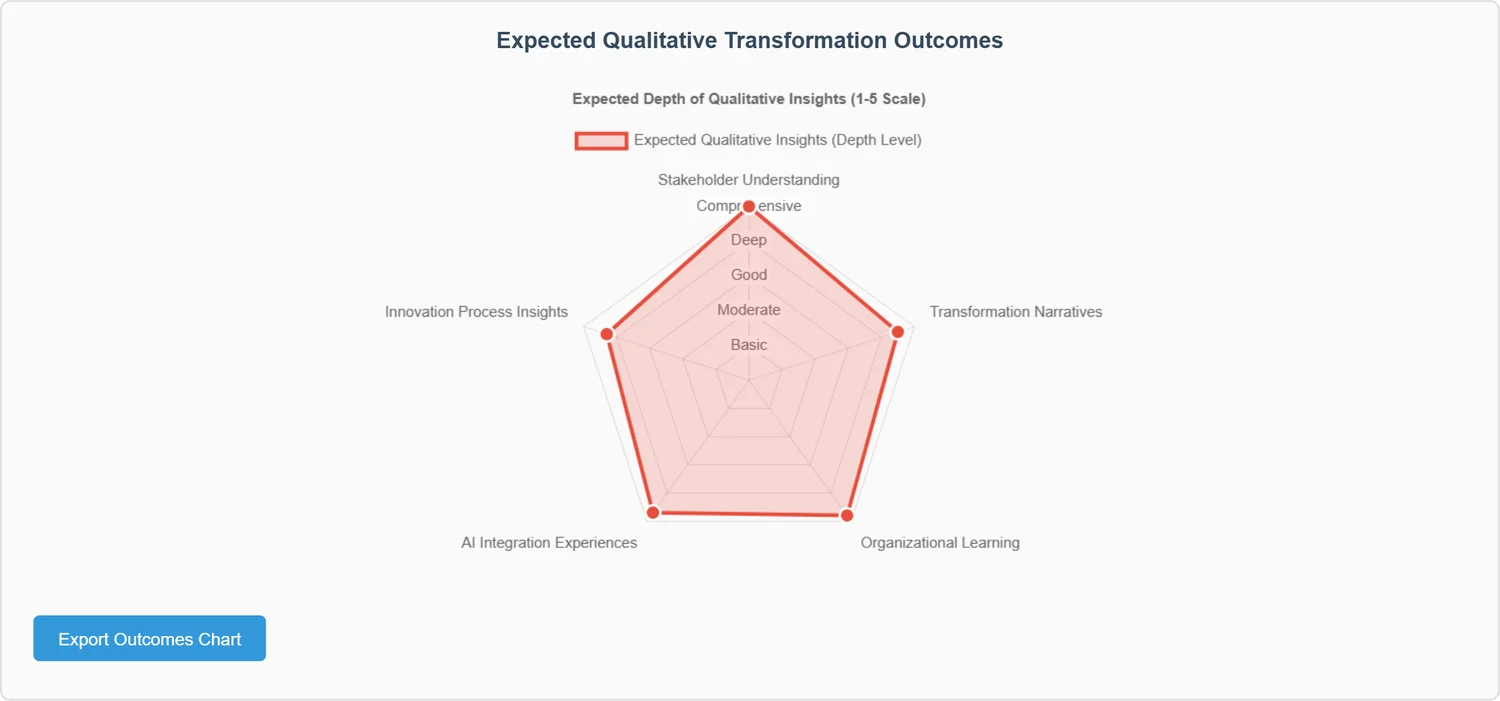
### 12.2 Practical Benefits
**AI Integration Guidelines**: Creation of practical implementation frameworks based on qualitative insights enabling Chinese start-ups to systematically integrate comprehensive AI tools for organizational transformation and innovation acceleration.
**Experience-Based Best Practices**: Development of stakeholder experience-based guidelines and assessment approaches for evaluating AI empowerment effectiveness and organizational agility enhancement.
**Transformation Process Documentation**: Comprehensive documentation of AI integration transformation experiences, implementation challenges, and solutions applicable to similar start-up contexts based on qualitative learning.
### 12.3 Organizational Impact for Company Y
**Qualitative Transformation Outcomes**:
- Enhanced understanding of AI-driven development processes through stakeholder experiences
- Improved organizational learning capabilities through comprehensive AI tool integration
- Strengthened collaborative capabilities through AI-enhanced team interactions
- Developed innovation mindset through systematic AI empowerment experiences
**Sustainable Capability Development**:
- AI-empowered sensing capabilities based on stakeholder learning and adaptation
- Enhanced decision-making processes through AI-supported organizational intelligence
- Improved knowledge management and organizational memory systems
- Strengthened adaptive capabilities for continuous innovation through comprehensive AI integration
### 12.4 Academic Contributions
**Publication Outcomes**:
- **Paper 1**: "AI Empowerment Mechanisms for Organizational Agility Enhancement: A Qualitative Study of Chinese Start-ups" (Target: Qualitative Research or similar Scopus Q1 journal)
- **Paper 2**: "From AI Integration to Innovation Acceleration: Stakeholder Experiences and Organizational Transformation" (Target: Journal of Business Research or similar Scopus Q1 journal)
**Conference Presentations**:
- Academy of Management Annual Meeting (Qualitative Research Division)
- International Conference on Qualitative Methods in Business Research
- Asia-Pacific Innovation Conference (Qualitative Track)
### 12.5 Broader Impact
**Chinese Start-up Ecosystem**: Research findings will provide qualitative evidence-based guidance for AI empowerment strategies, contributing to the understanding of transformation experiences in Chinese start-ups.
**Policy Implications**: Results will inform government policies supporting AI adoption in start-up environments through stakeholder experience insights, particularly regarding training, infrastructure, and support mechanisms.
**Industry Applications**: Qualitative frameworks and guidelines developed will be applicable beyond Company Y, supporting AI transformation initiatives across various industry sectors based on stakeholder learning and organizational experiences.
---
## Supporting Materials
**Interactive Charts and Diagrams**: Comprehensive visual representations of the research framework, AI tools integration strategy (including 即梦AI and self-developed tools), qualitative research design, stakeholder analysis matrix, research timeline, and organizational agility transformation model are available in the accompanying HTML file (`research_proposal_charts_v2.html`). These charts include export functionality for presentation and publication purposes.
**Key Visual Components**:
- AI Empowerment Research Framework (Qualitative Focus)
- Comprehensive AI Tools Integration Strategy (5 categories)
- Qualitative Research Design and Data Collection Methods
- Stakeholder Analysis and Participation Framework
- 24-month Research Timeline with qualitative milestones
- Organizational Agility Transformation Model (Experience-Based)
---
## Research Team and Timeline
**Research Team**:
- **Principal Investigator**: Dr. Farah (Lead Researcher)
- **Research Student**: Leo (Weng Yonggang) (PhD Candidate, Primary Implementer)
**Research Period**: October 1, 2025 - September 30, 2027 (24 months)
**Expected Deliverables**:
- Two Scopus-indexed journal publications focusing on qualitative AI empowerment mechanisms and organizational transformation experiences
- Comprehensive qualitative research report with practical implementation guidelines
- Experience-based frameworks and tools for AI integration assessment
- Conference presentations at international venues (qualitative research focus)
- Best practices documentation for Chinese start-up AI adoption based on stakeholder experiences
**Budget Considerations**: Research funding will support comprehensive AI tool licensing (5 categories), external agile coaching, qualitative data collection infrastructure, transcription services, qualitative analysis software, publication fees, and conference participation costs.
**Success Criteria**:
- Deep qualitative understanding of Company Y's organizational agility and innovation transformation
- Successful publication of qualitative research findings in high-impact journals
- Development of replicable qualitative frameworks for AI empowerment in start-up contexts
- Contribution to theoretical understanding of AI-organizational agility relationships through stakeholder experiences
加载中...
正在加载内容...
附件 0
加载中...
正在加载附件列表...
0
0
11
评论 (0)
请 登录 后发表评论
暂无评论,来留下第一条评论吧
关于作者
Leo_UTM
已认证用户加入时间: 2025-05-03
文章数量: 27
相关文章
Chango Editor 一个强大的免费的代码编辑器
原创
从前慢
10-06
马来西亚租房地域全攻略:从城市核心到特色社区的深度解析
原创
租房找我
09-02
马来西亚吉隆坡有什么好玩的
原创
小六吖
08-06
全网最火的Google Gemini CLI,详细安装图文教程来了
原创
Leo_UT...
07-01
✨【马来亚大学官方见面会】✨
原创
小六吖
06-17
【学习频道】操作指南
原创
椰风学子
05-29
【二手物品】操作指南
原创
椰风学子
05-29
【租房信息】操作指南
原创
椰风学子
05-27
Enhancing Product Innovation in Start-ups: A Scoping Review on the Integration of Lean Startup
原创
Leo_UT...
05-21
Decision analysis techniques — decision trees, influence diagrams, and Monte Carlo simulation
原创
从前慢
05-20
?诚邀首席体验官,每天花10分钟拿10马币+?
原创
椰风学子
05-19
研究表明,结合精益创业、客户参与、组织文化和人工智能可以显著提升初创企业的产品创新表现
原创
从前慢
05-17
发表英文论文选择国际期刊,期刊的Impact Factor、CiteScore和SNIP分别是什么意思?
原创
从前慢
05-14
Research Report on the Consumption Trend of NMN Health Products in Singapore over the Past Five Year
原创
从前慢
05-13
新加坡NMN保健品近5年消费趋势调研报告
原创
从前慢
05-13
马来西亚留学生申请MyRapid学生卡保姆级教程
原创
小六吖
05-06
每天认识一所马来西亚名校——马来西亚排名前30 玛拉工艺大学 (UiTM)
原创
小六吖
05-06
第48篇:构建企业级大模型应用的架构设计
原创
莱昂纳多
05-06
每天认识一所马来西亚名校——马来西亚排名前30 亚太科技大学 (APU)
原创
小六吖
05-06
每天认识一所马来西亚名校——马来西亚排名前30 马来西亚苏丹伊德里斯教育大学 (Universiti Pendidikan Sultan Idris)
原创
小六吖
05-06